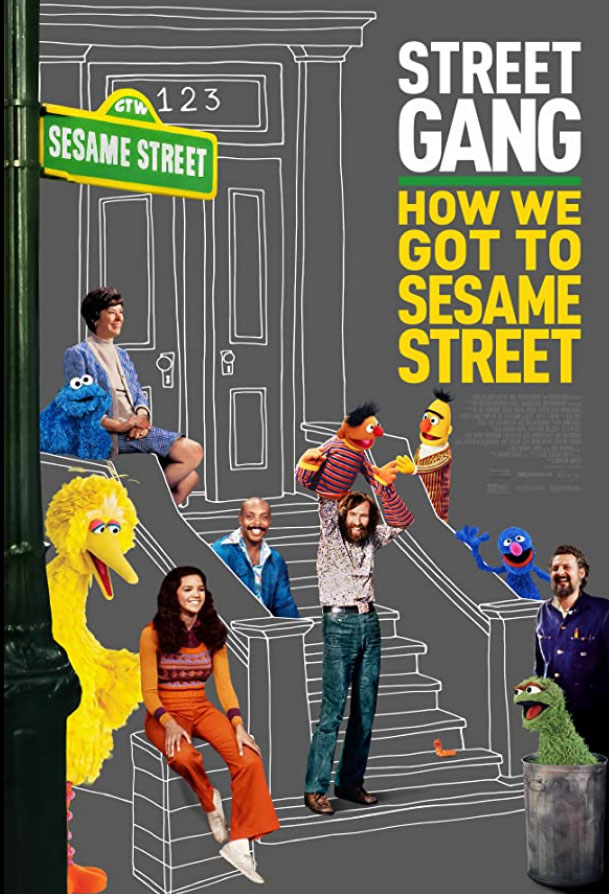About a decade ago I took my nephew, a child at the time, to see a rare live production of “Sesame Street” that was touring the region. It was an unlikely opportunity to see the muppets and the warm, thoughtful creativity of the show in real-life, on a stage, rather than projected onto a television screen. Even without the familiar human faces of the show, or without the original voice performers for the muppets, there was an unmistakable electricity. You could feel it in the audience. Such is the nature of “Sesame Street”. An unlikely creative, and commercial success that emerged from a clear educational purpose into a long running TV show that has charmed generations for decades. There’s an unceasing warmth to the show, its fabric, its ideas and its very existence that is next to impossible to resist. And it’s that inherent warmth that the newly released documentary “Street Gang: How We Got to Sesame Street” depends on.
Marilyn Agrelo’s documentary is a polite film inspired by “Street Gang”, the nonfiction book chronicling the development of the programme. And it’s an interesting story. The idea emerged after a dinner party hosted by co-creator, Joan Ganz Cooney and her husband in the mid-sixties. It was a pitch to harness the addictive power of television for good; a way to reach audiences that were disenfranchised by the school system, or had trouble getting access to early education. But rather than a didactic learning show, they would seek to cloak the education in something attractive to children. What seemed like a gamble at the time became a smashing success using Jim Henson’s muppet creations and a long line of human characters alongside them, as well as notable guest stars. The most emotionally incisive moments of the documentary work as a sharp memorialisation of Henson, who died in 1990. In that section, it engages with the way that behind-the-scenes production moments of the show affect the output. In examining the ways that the show handled grief for children, the section sheds light on the ways that a long-running show like “Sesame Street” becomes more than just a mechanical product but a thoughtful piece of television that sees the humanity in its characters and audiences. And it stands out because of how less incisive the film around it is.
Most persons have their own individual “Sesame Street” histories; how they came to know the show, their favourite characters, and moments that they recall. The show’s longevity is legend and the nostalgia effect is a major part of Agrelo’s narrative style. But, stylistically, the talking-heads come to feel too prosaic too soon, especially when “Street Gang” is not doing much with the narrative. We go through the expected routes of cast members talking about their first days, and the uncertainty of the show’s success but Agrelo seems disinclined to dig deeper. There’s no compulsion for the documentary to go darker, but as much as the individual moments of recognition work the through-line in “Street Gang” to establish a thesis for itself wavers too often.
But, for much of its emotional beats Agrelo cripples the film by making it depend on recognition of the familiar rather than exploration of anything innovative or new. Even in its consideration of the show’s beginning, the reality of why so many poor children in the U.S. needed a show like this goes unspoken. It feels like a cliff-notes account of the show’s greatest hits. It is not necessarily a bad thing and still entertaining but rather than using its documentary form to tell a story different from the show, Agrelo’s tone seems to be imitating the effect of the show itself, which leaves “Street Gang” paler by comparison. It also did not help that I saw it first at “Sundance” which featured technically and narratively daring work like the animated documentary “Flee”.
It’s warm and sweet and it’s charming in that way, like a meeting with old friends might be. But, as a narrative and as a piece of creative film, it’s strangely uncurious about its own self – superficial and even ambivalent in moments that seem to demand more excavating. The camera is too congenial and uncreative to be daring, or even dig into spaces the narrative may not immediately go to. It would be near impossible to find yourself in a bad mood after watching it. It’s all too gentle and warm for that. But, it also resists lingering in your brain in a way that feels antithetical to the show itself. The gossamer threads of “Sesame Street” the show linger long after it disappears but “Street Gang” offers only the most ephemeral of pleasures.
Street Gang is available to watch Video On Demand currently and is also streaming on HBOMax which will launch in the region in June.







